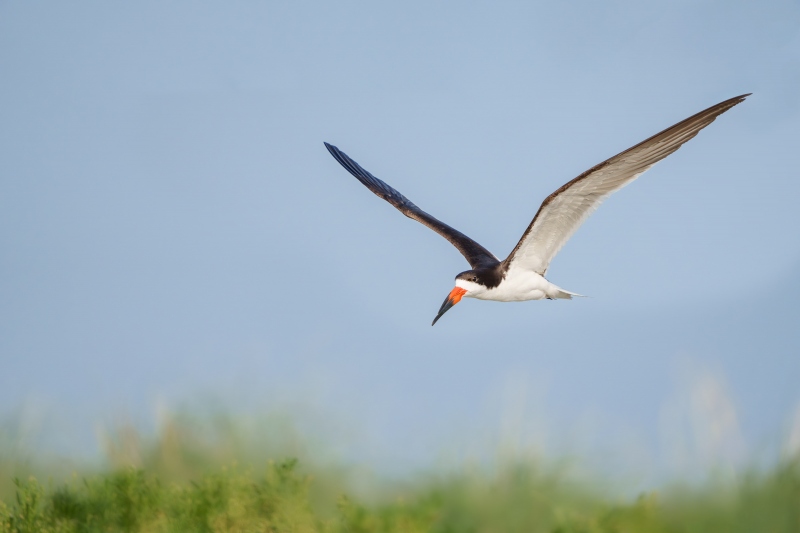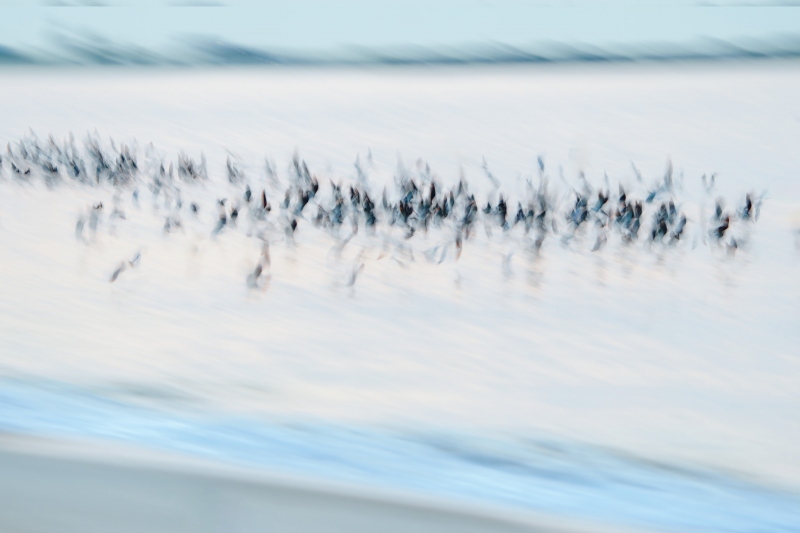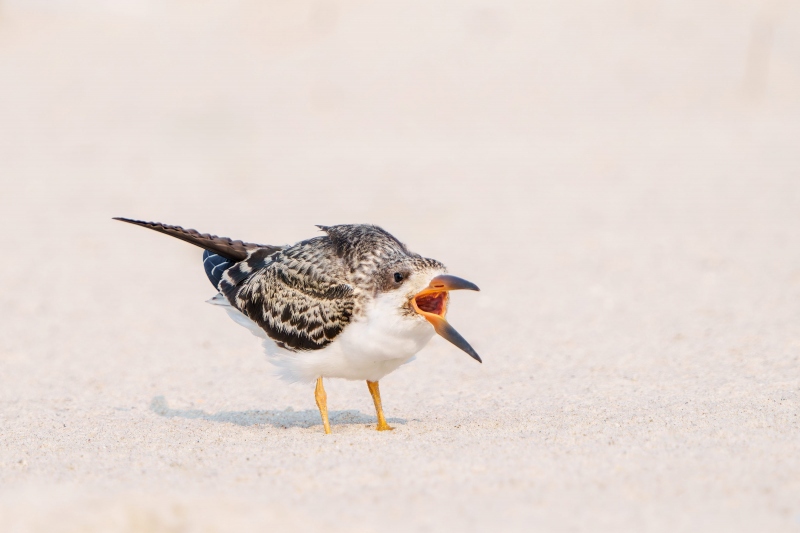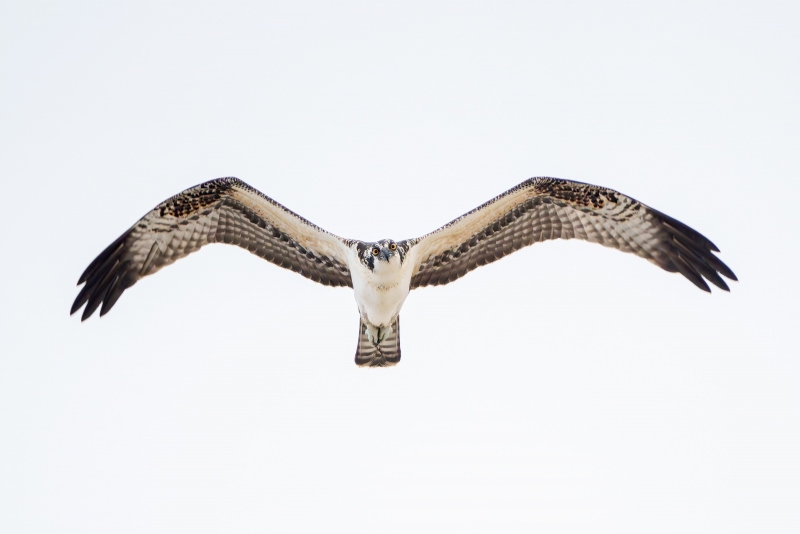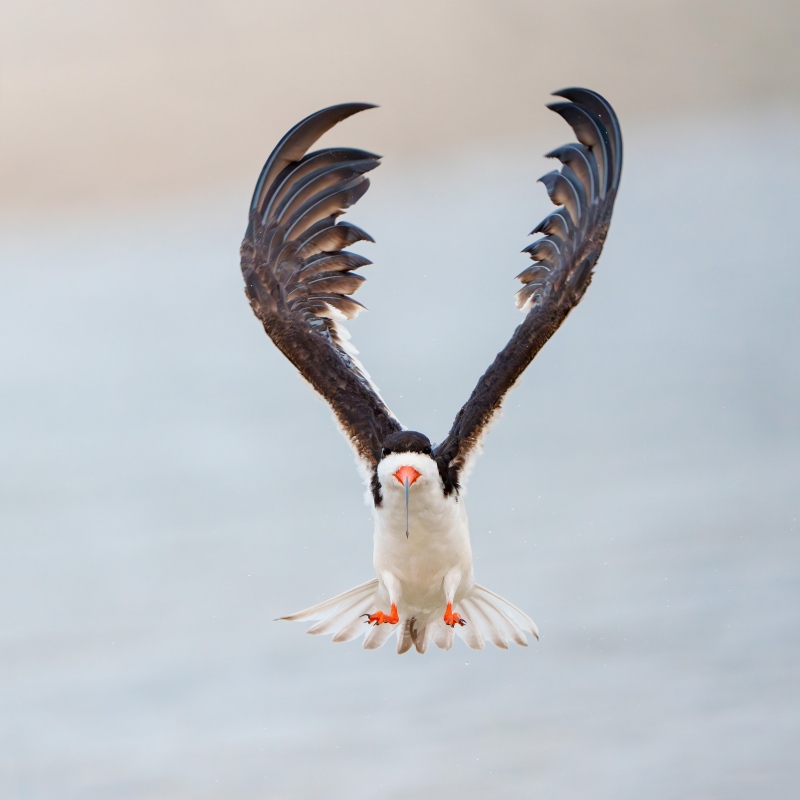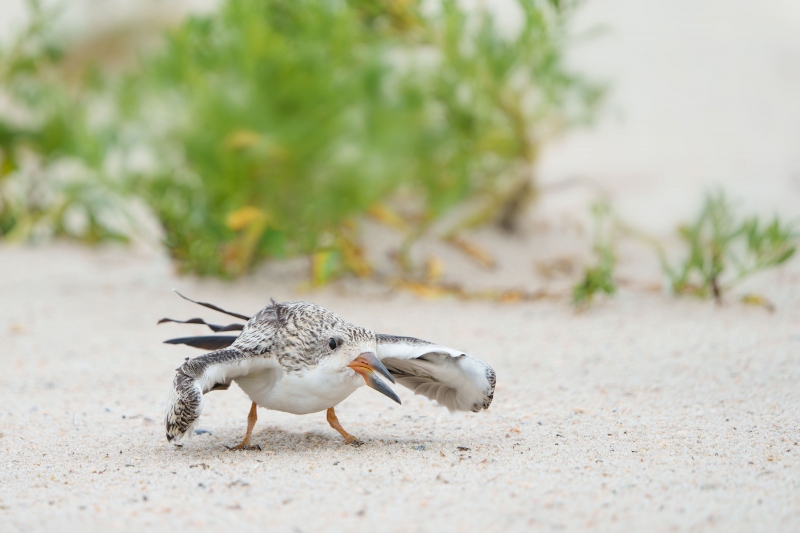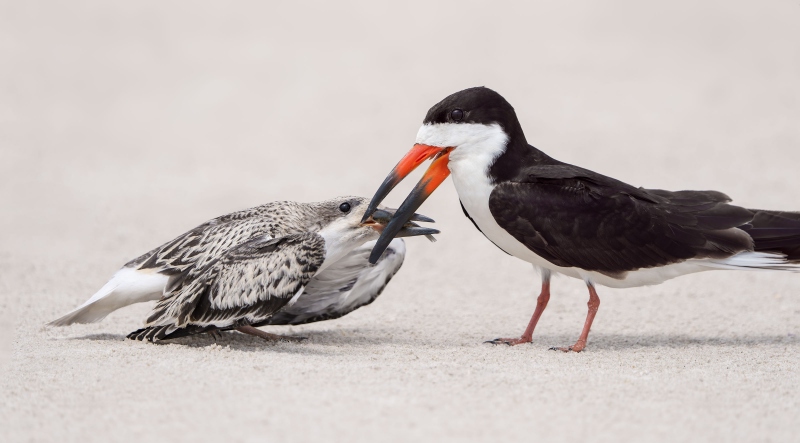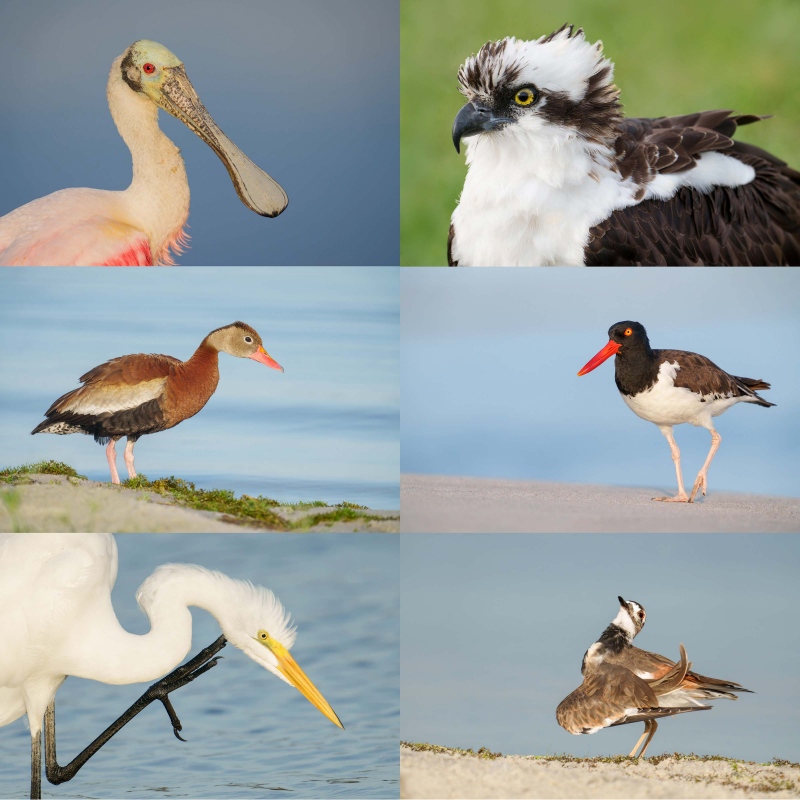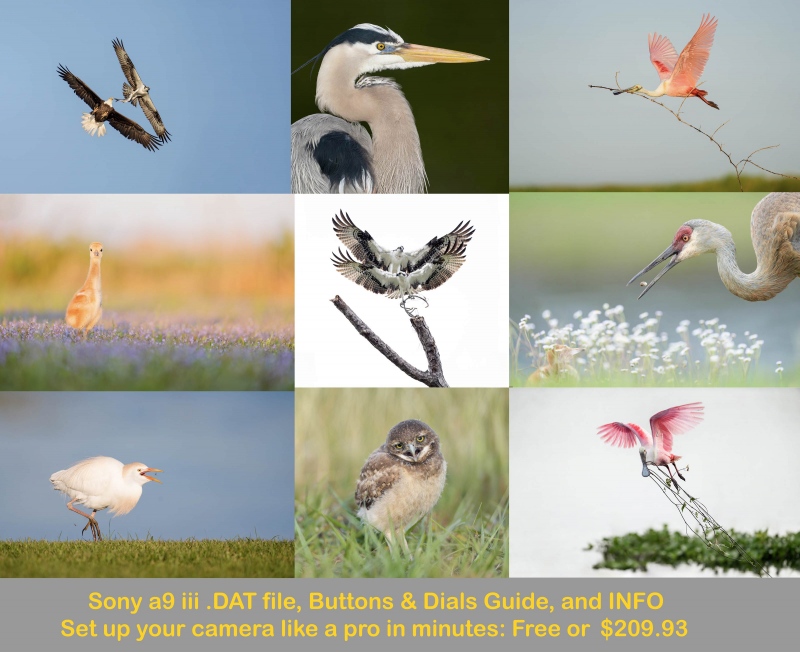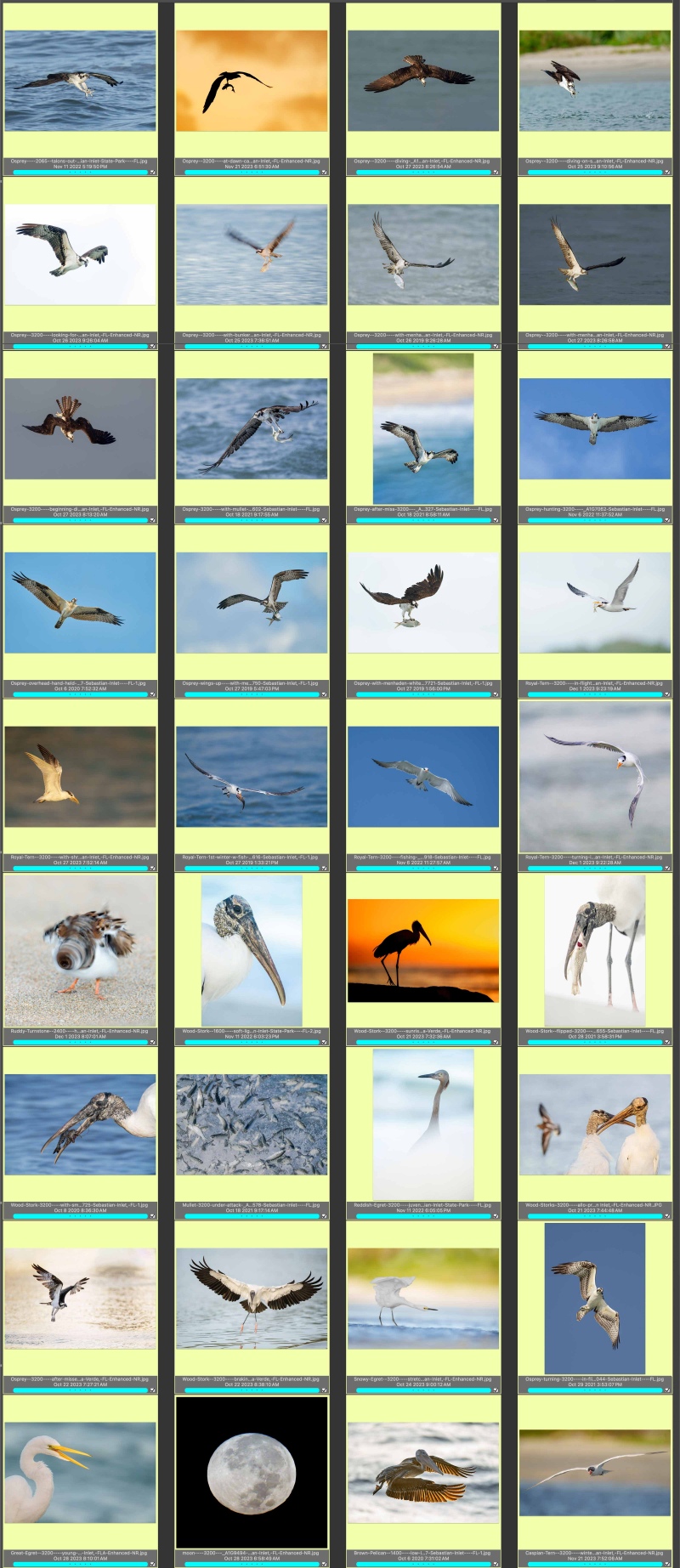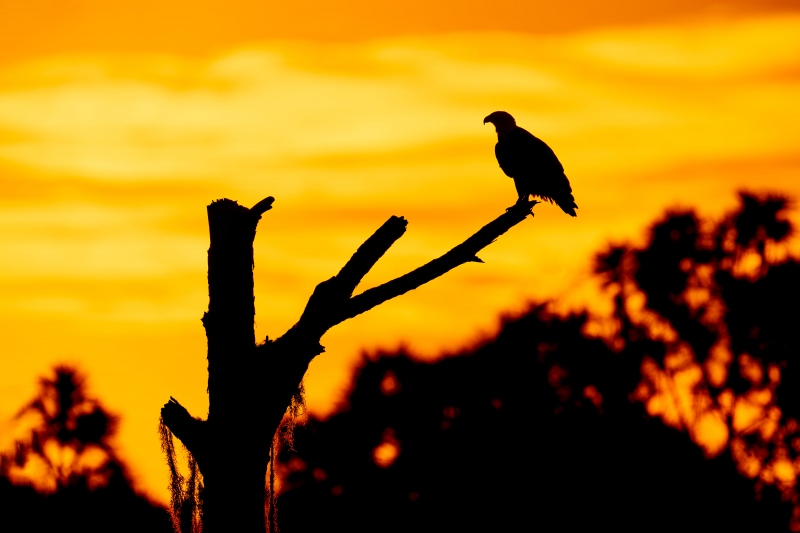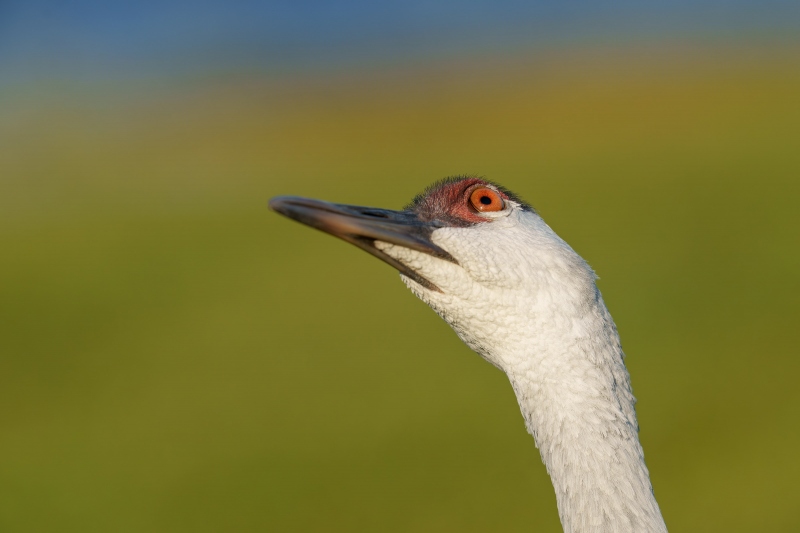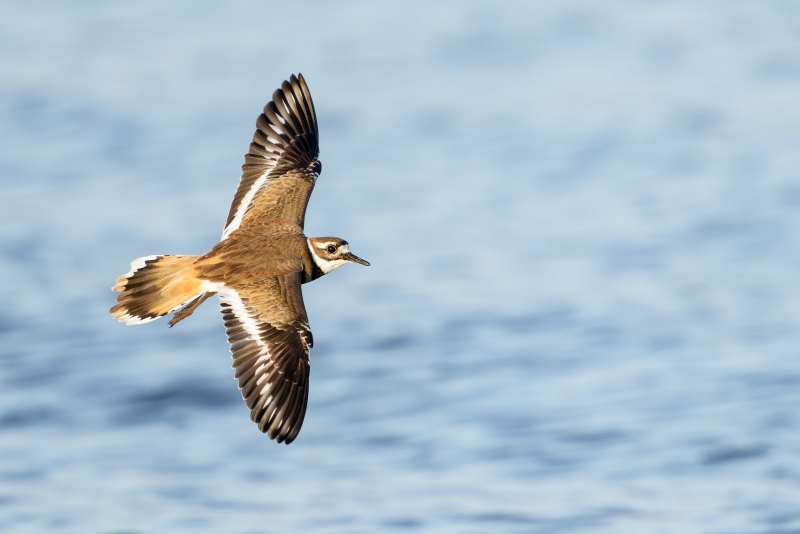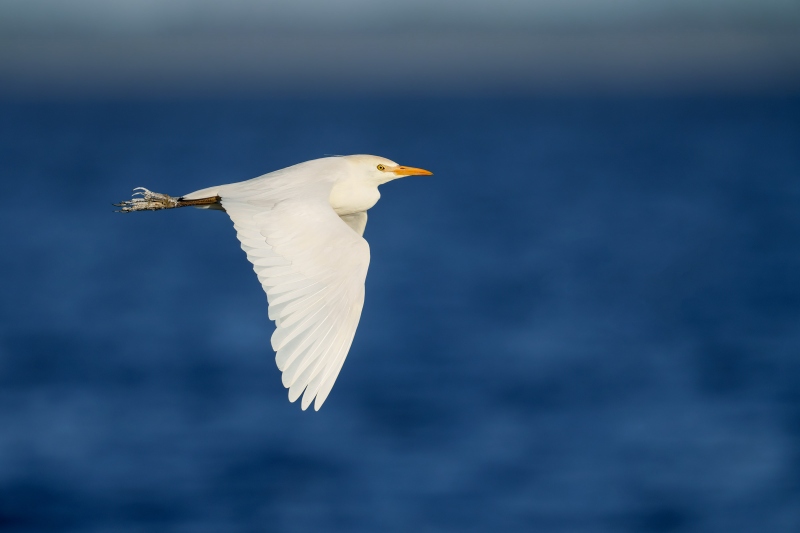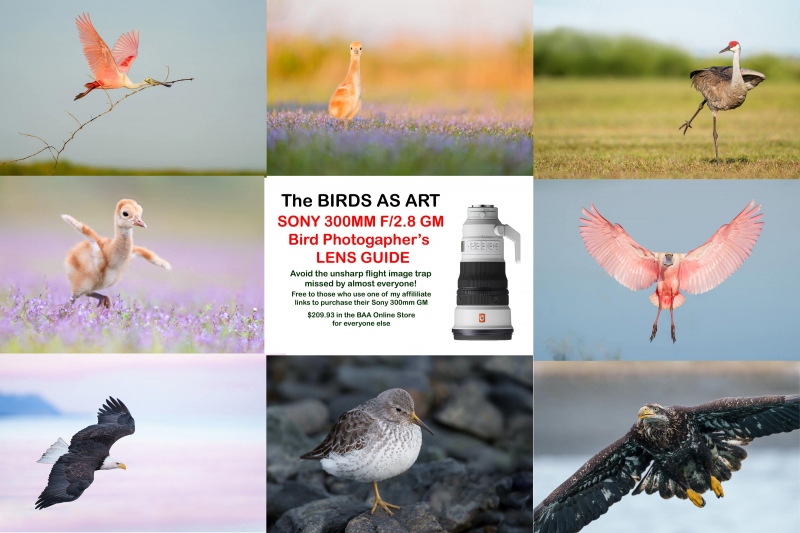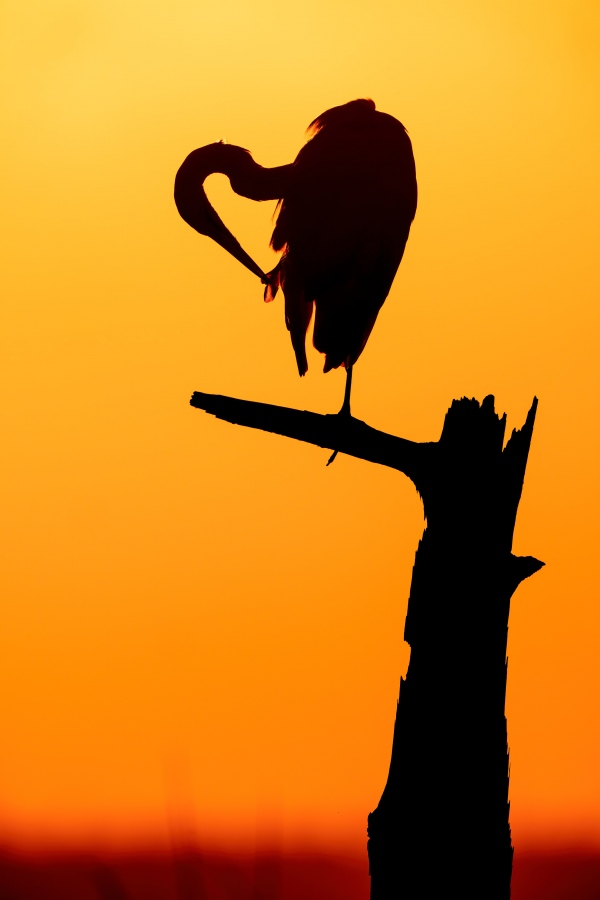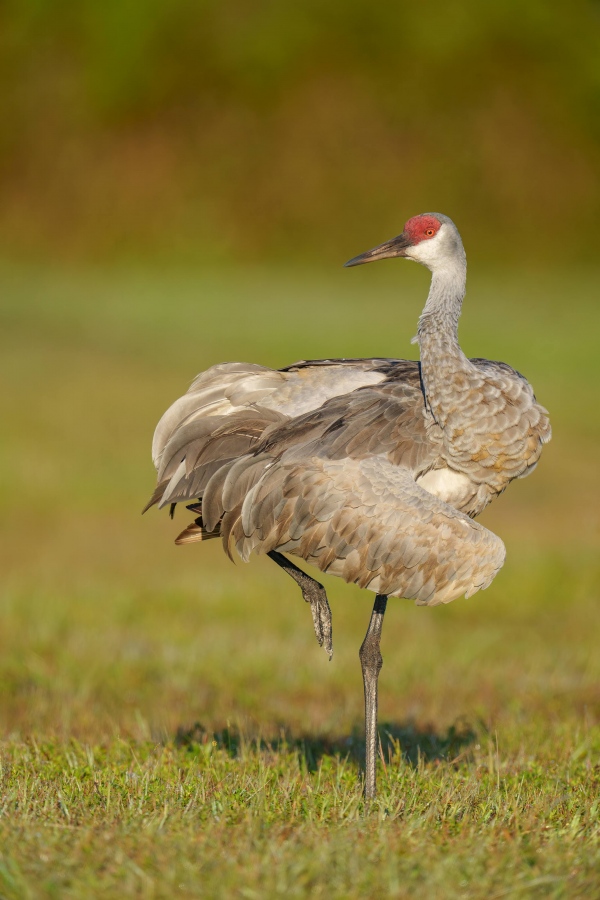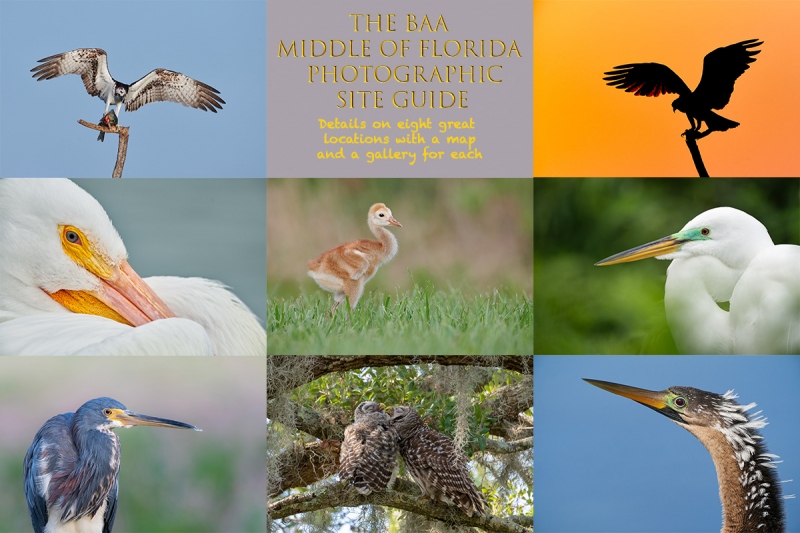October 30th, 2024 What’s Up?
Bob Eastman and I had a great first morning at Sebastian. Aside from a zillion Ospreys fishing the inlet, a cooperative white Morph Reddish Egret on the beach made our day. The afternoon looked like bird photography death with a strong SE wind and sunny blue skies but I scouted around and found a fabulous afternoon spot with lots of tame wading birds, many of them in the shade. I hate to give up even on a single session. There is still lots of room in our lovely AirBbB just 22 minutes from the inlet. Get in touch via e-mail to explore the possibility of joining us.
One of the great advantages of joining me on an IPT or an Extended IPT is that I will get to look at and process your best images while creating a screen capture Camtasia video to share with you and the group. The image optimizations for all seven of todays images were done by yours truly, Arthur Morris/BIRDS AS ART.
Geri’s images show just what can be done with “just” the Sony FE 200-600mm f/5.6-6.3 G OSS lens (at 600mm) and The One, the Sony Alpha 1 Mirrorless digital camera. ) If you would like to learn more about switching to Sony, please get in touch via e-mail.
I was glad to learn that Karen McCormick sold her brand new Sony 600mm f/4GM lens for the full asking price within an hour of it being listed. She still has a great a9 iii for sale.
Today is Wednesday 30 October 2024. We will be heading back to the state park well before sunrise. I hope that all of you boys and girls have a wonderful day too. Today’s post featured the work of longtime friend and student Geri Georg of Colorado. She joined me for both the DeSoto IPT last spring and Extended IPT at Nickerson Beach. As with many, many others, I helped Geri transition from Canon to Sony about two years ago.
Please remember to use the B&H links that are found on most blog pages and to use the BIRDSASART discount code at checkout when purchasing your new gear from Bedfords to get 3% back on your credit card and enjoy free second-day air FedEx. Please, also, consider joining a BAA IPT. You will be amazed at how much you will learn!
If an item — a Delkin flash card, or a tripod head — for example, that is available from B&H and/or Bedfords, is also available in the BAA Online Store, it would be great, and greatly appreciated, if you would opt to purchase from us. We will match any price. Please remember also to use my B&H affiliate links or to earn 3% cash back at Bedfords by using the BIRDSASART discount code at checkout for your major gear purchases. Doing either often earns you free guides and/or discounts. And always earns my great appreciation.
Supporting My Efforts Here
If you enjoy and learn from the blog, are all set for gear, or live overseas, consider leaving a BAA Blog Thank You Gift here.
If you enjoy and learn from the blog, please consider using one of my affiliate links when purchasing new gear. It will never cost you a single penny. To support my effort here, please order from B&H by beginning your search here. Or, click here, to order from Bedfords and enter the discount code BIRDSASART at checkout to receive 3% cash back to your credit card and enjoy free Second-Day Air Fed-Ex shipping. It is always best to write for advice via e-mail.
In many cases, I can help you save some serious dollars. And/or prevent you from purchasing the wrong gear from the wrong shop.

Save 15%!
If you’d like to try out a new lens or if you need a lens for a specific trip or project (or for an IPT), LensRentals.com is the only way to go. To save 15%, simply click on the logo link above, arrange for your rental, and type in BIRDSASART15. If you type the gear you are looking for in the search box, it will pop right up. LensRentals.com offers affordable insurance. You can decline it, opt for LensCap: Damage Only, or select LensCap: Damage & Theft. Then hit PROCEED TO CHECKOUT. After you enter all of your info but before completing your order, be sure to scroll down to Promo Code box and enter the BIRDSASART15 code to save 15%.
I checked on renting a Sony FE 70-200mm f/2.8 GM OSS II lens for a week. The cost is only $122.00. LensCap: Damage Only coverage can be added for a very low $18.00. Going with LensCap: Damage & Theft would be $27.00. The shipping charge varies. They offer an interesting program called Lensrentals HD. By signing up for this shipping discount program ($99.00/year), you’ll get free Standard Shipping on all the orders you place.
Renting a Sony 600mm f/4 GM OSS lens for a week will cost you $536.00. The two coverage options come in at $76.00 or $114.00. Less your 15% discount when you enter the BIRDSASART15 code into the Promo Code box at checkout and enter the BIRDSASART15 code in the Promo Code box at checkout to save 15%.
Remember, to save the 15% on your rental you must start your search by clicking on the logo above, or on this link: LensRentals.com
Canon EF 70-200mm f2.8L IS II USM Lens
Mark Harrington is offering a Canon EF 70-200mm f2.8L IS II USM refurbished by Canon to Like-New condition for a very low $850.00. The sale includes the lens with front and rear caps, original product box, manual and software, Lens case LZ1326 and Lens Hood and insured ground shipping via major courier to lower-48 US addresses only.
Your item will not ship until your check clears unless other arrangements are made.
Please contact Mark via e-mail at e-mail or by phone at 1-612-308-5776 MST.
The Canon RF 70-200mm f/2.8 lens is an abomination. Why? Because the lens does not accept either teleconverter. Hard to believe, but true. If you shoot Camon mirrorless you are far better off with this lens and the EF to RF Adapter. Thus, the versatility of this popular lens is wrecked.
The versatile 70-200mm f/2.8 lenses have long been big favorites of many nature photographers. They are great for landscapes especially with fall color peaking in many areas. I have used this lens with Canon and Nikon and SONY. I used my Canon version to photograph granddaughter Maya’s dance recitals and to create bird-scapes and pre-dawn blast-off blurs at Bosque del Apache NWR in New Mexico. They are fast and sharp and have 1000 uses. The 70-200 f/2.8 lenses are a specialty lens for bird photographers. Like the bad little child, when they are good, they are really, really good! I’ve used mine mostly for flight photography at point blank range where their performance is unmatched, especially in low light. I’ve killed with these lenses on the gannet boat in the UK, in Homer for eagles, for pre-dawn and blizzard blast-offs at Bosque, and at Merritt Island on feeding sprees right next to the road. Lenses in this class are easily hand holdable by just about everyone. artie
ps: To see what the 70-200 zoom lenses can do, see the blog post here.
|
|
|
This image was created on 14 August 2024 on a Nickerson Beach Extended IPT by friend and multiple IPT veteran Geri Georg. Standing, she used the hand held Sony FE 200-600mm f/5.6-6.3 G OSS lens (at 600mm) and The One, the Sony Alpha 1 Mirrorless digital camera. ) The exposure was determined using Zebra technology with ISO on the Thumb Dial. ISO 800. 1/4000 second at f/6.3 (wide-open) in Manual Mode. AWB at 6:11:52pm on a sunny afternoon. RawDigger showed the raw file brightness to be perfect.
Zone AF-C with Bird Face/Eye Detection performed perfectly. Be sure to click on the image to enjoy a high-res version.
Image #1: Black Skimmer adult in flight
Image courtesy of and copyright 2024: Geri Georg
|
Shutter Speeds for Flight Photography
From where I sit, 1/4000 second is a great first choice for flight photography. 1/2500 and 1/3200 second are fine for most flying birds. You can often get away with 1/2000, 1/1600 or even 1/1250 second. Anything slower, and you need to pan perfectly with the bird to get the eye sharp. Some folks like 1/8000 second to completely eliminate wing tip blur. I rarely go there as I do not mind blurred wingtips as they convey motion. Remember that with film we shot flight at 1/500 second.
All that said, on rare occasion, it is possible to get the eye of a flying bird sharp at speeds as slow as 1/60 or 1/30 second. But never consistently.
Kudos for Geri to picking my favorite sunny day shutter speed for flight: 1/4000 second.
|
|
|
This image was created on 15 August 2024 on a Nickerson Beach Extended IPT by friend and multiple IPT veteran Geri Georg. Standing, she used the hand held Sony FE 200-600mm f/5.6-6.3 G OSS lens (at 600mm) and The One, the Sony Alpha 1 Mirrorless digital camera. ) The exposure was determined using Zebra technology with Exposure Compensation on the Thumb Dial. Multi Metering +2/3 stop. AUTO ISO set ISO 400. 1/8 second at f/6.3 (wide-open) in Shutter Priority mode. AWB at 6:59:25am on a cloudy morning. RawDigger showed the exposure to be 1/3 stop under.
Zone AF-C with Bird Face/Eye Detection performed perfectly. Be sure to click on the image to enjoy a high-res version.
Image #2: Black Skimmer flock blastoff blur
Image courtesy of and copyright 2024: Geri Georg
|
Getting Out Early
If you are walking down to the beach when it is still dark, blurs are often your only choice until the sun comes up. On IPTs, when blurs are on the table and the backgrounds are consistently light toned, I teach folks to work in Shutter Priority mode with AUTO ISO and Exposure Compensation (EC) on a convenient dial or wheel. Kudos to Geri for being open to new concepts and especially for digging blurs. Not everyone does.
Let’s see what ISO you would have needed to get to a shutter speed of 1/2000 second that early that morning.
1/8 @ ISO 400
1/15 @ ISO 800
1/30 @ ISO 1600
1/60 @ ISO 3200
1/125 @ ISO 6400
1/250 @ ISO 12800
1/500 @ ISO 25600
1/1000 @ ISO 51200
1/2000 @ ISO 102400
Necessity is often the mother of invention when it comes to photographing in extreme low light conditions. Blurs anyone?
|
|
|
This image was created on 16 August 2024 on a Nickerson Beach Extended IPT by friend and multiple IPT veteran Geri Georg. Seated on dry sand, right next to me, she used the hand held Sony FE 200-600mm f/5.6-6.3 G OSS lens with the Sony FE 1.4x Teleconverter (at 840mm) and The One, the Sony Alpha 1 Mirrorless digital camera. ) The exposure was determined using Zebra technology with ISO on the Thumb Dial. ISO 1250. 1/1600 second at f/9 (wide-open) in Manual Mode. AWB at 9:23:45am on a barely cloudy very bright morning. RawDigger showed the raw file brightness to be perfect.
Zone AF-C with Bird Face/Eye Detection performed perfectly. Be sure to click on the image to enjoy a high-res version.
Image #3: Black Skimmer — large chick barking
Image courtesy of and copyright 2024: Geri Georg
|
200-600 with the 1.4X TC
As the birds were not letting us get very close, I suggested to Geri that she add the 1.4X to get more pixels on the bird. She did, and she did. Not all students listen to the instructors suggestions 🙂 Good on Geri!
|
|
|
This image was created on 17 August 2024 on a Nickerson Beach Extended IPT by friend and multiple IPT veteran Geri Georg. Seated on dry sand, she used the hand held Sony FE 200-600mm f/5.6-6.3 G OSS lens (at 600mm) and The One, the Sony Alpha 1 Mirrorless digital camera. ) The exposure was determined using Zebra technology with ISO on the Thumb Dial. ISO 8000! 1/1250 second at f/6.3 (wide-open) in Manual Mode. AWB at 7:58:39 am on a very cloudy morning. RawDigger showed the raw file brightness to be perfect.
Zone AF-C with Bird Face/Eye Detection performed perfectly. Be sure to click on the image to enjoy a high-res version.
Image #4: Osprey directly overhead staring at photographer
Image courtesy of and copyright 2024: Geri Georg
|
You’ve Heard This One Before
When the shot is there, press the shutter button; if you try to change anything, you will wind up with nothing. Above, I suggested that 1/4000 sec. is a great choice for flight photography. When Geri saw the Osprey above looking right down at her, she pressed the shutter button despite the relatively slow of flight shooting shutter speed of 1/1600 sec. Then, she got a bit lucky. The better your hand holding sharpness techniques, the luckier you will get.
|
|
|
This image was also created on 17 August 2024 on a Nickerson Beach Extended IPT by friend and multiple IPT veteran Geri Georg. Seated right next to me on damp sand, she used the hand held Sony FE 200-600mm f/5.6-6.3 G OSS lens (at 600mm) and The One, the Sony Alpha 1 Mirrorless digital camera. ) The exposure was determined using Zebra technology with ISO on the Thumb Dial. ISO 5000! 1/2500 second at f/6.3 (wide-open) in Manual Mode. AWB at 10:00:52am on a cloudy morning. RawDigger showed the raw file brightness to be perfect.
Zone AF-C with Bird Face/Eye Detection performed perfectly. Be sure to click on the image to enjoy a high-res version.
Image #5: Black Skimmer adult jumping up after bath
Image courtesy of and copyright 2024: Geri Georg
|
Wind Direction and Bathing Birds
Bathing birds will almost always jump into the air at the end of their bath; those that do will always jump up and flap while facing into the wind, just as they do when taking flight. We stayed late on a stormy morning and used the NE wind to our advantage while working a receding tidal pool.
|
|
|
This image was created on 18 August 2024 on a Nickerson Beach Extended IPT by friend and multiple IPT veteran Geri Georg. Seated on dry sand, she used the hand held Sony FE 200-600mm f/5.6-6.3 G OSS lens (at 600mm) and The One, the Sony Alpha 1 Mirrorless digital camera. ) The exposure was determined using Zebra technology with ISO on the Thumb Dial. ISO 800. 1/1600 second at f/6.3 (wide-open) in Manual Mode. AWB at 1:19:30pm on a cloudy day. RawDigger showed the raw file brightness to be perfect.
Zone AF-C with Bird Face/Eye Detection performed perfectly. Be sure to click on the image to enjoy a high-res version.
Image #6: Black Skimmer large chick begging posture
Image courtesy of and copyright 2024: Geri Georg
|
Why Were We on the Beach at 2pm?
It was pouring rain when we woke up in our AirBnB on Lido Beach, Long Island, NY. We worked on images for a few hours and when the rain quit and the sky brightened just a bit, I said, “Let’s go. We’ll see if they are letting folks in for free because of the bad weather. They were and we had a great afternoon session.
|
|
|
This image was also created on 18 August 2024 on a Nickerson Beach Extended IPT by friend and multiple IPT veteran Geri Georg. Seated on dry sand right nest to me, she used the hand held Sony FE 200-600mm f/5.6-6.3 G OSS lens (at 600mm) and The One, the Sony Alpha 1 Mirrorless digital camera. ) The exposure was determined using Zebra technology with ISO on the Thumb Dial. ISO 250. 1/1600 second at f/6.3 (wide-open) in Manual Mode. AWB at 2:10:47pm on a cloudy day. RawDigger showed the raw file brightness to be perfect.
Zone AF-C with Bird Face/Eye Detection performed perfectly. Be sure to click on the image to enjoy a high-res version.
Image #7: Black Skimmer adult feeding large chick
Image courtesy of and copyright 2024: Geri Georg
|
The Feeding Shot!
Tern and skimmer chick feeding shots are difficult to impossible for two main reasons:
1- The odds of getting two good head angles is always at least four to one against you.
2- Getting a decent look at the faces of both the adult and the chick is very challenging.
3- Having both the adult and the chick nicely juxtaposed with regards to the imaging sensor might be the biggest challenge of all.
Kudos to Geri on all counts for Image #7. And big time thanks for allowing me to share your work with the boys and girls here on the blog.
Typos
With all blog posts, feel free to e-mail or to leave a comment regarding any typos or errors, or to ask a question.
October 28th, 2024 A First Ever Request
The item below appeared in the Safe to Go in the Water. Six images made with a v2.02 a-1 blog post here.
Your Call
The challenge today is to put today’s six featured images in order with the strongest one first and the weakest image (in your eyes) last. As each of the images is quite strong, you will need to put on your critiquing hat to sort them out. Be sure to click on each one to enlarge it. Don’t be a chump; have some fun and take a shot at the challenge. I will share my list in the next blog post that will feature the work of Geri Georg on the Nickerson IPT.
Thanks to the few who posted a comment.
If you enjoy the blog but did not leave a comment with your list, please take a moment to re-visit the last post and leave a comment. Your doing so would be greatly appreciated. Tuesday’s post will feature the work of BAA friend and student Geri Georg. In addition, I will share my ranking of the six photos in the previous post.
What’s Up?
Bob Eastman and I have been having a blast, photographing every morning and every afternoon since he drove down from Wisconsin and arrived midday on Friday. Though photography has not been great at ILE, each of us has made some excellent images in most every session. Today is Monday 28 October 2024. We will be driving over to Sebastian this afternoon where we will be staying in an AirBnB for 26 nights, hoping to put a hurt on the Ospreys diving for fish. There is still lots of room at the inn. If you would like to join us, scroll down for the details. We hope that you too choose to have a wonderful day.
Please remember to use the B&H links that are found on most blog pages and to use the BIRDSASART discount code at checkout when purchasing your new gear from Bedfords to get 3% back on your credit card and enjoy free second-day air FedEx. Please, also, consider joining a BAA IPT. You will be amazed at how much you will learn!
If an item — a Delkin flash card, or a tripod head — for example, that is available from B&H and/or Bedfords, is also available in the BAA Online Store, it would be great, and greatly appreciated, if you would opt to purchase from us. We will match any price. Please remember also to use my B&H affiliate links or to earn 3% cash back at Bedfords by using the BIRDSASART discount code at checkout for your major gear purchases. Doing either often earns you free guides and/or discounts. And always earns my great appreciation.
Supporting My Efforts Here
If you enjoy and learn from the blog, are all set for gear, or live overseas, consider leaving a BAA Blog Thank You Gift here.
If you enjoy and learn from the blog, please consider using one of my affiliate links when purchasing new gear. It will never cost you a single penny. To support my effort here, please order from B&H by beginning your search here. Or, click here, to order from Bedfords and enter the discount code BIRDSASART at checkout to receive 3% cash back to your credit card and enjoy free Second-Day Air Fed-Ex shipping. It is always best to write for advice via e-mail.
In many cases, I can help you save some serious dollars. And/or prevent you from purchasing the wrong gear. From the wrong shop.
|
|
BIRDS AS ART SONY 600mm f/4 Images
|
Sony 600mm f/4 GM OSS Lens
Brand new in the box!
Used Gear Page regular Karen McCormick is offering a brand new in the box Sony 600mm f/4 GM OSS lens for a ridiculously low $9998.00. The sale includes the original product box and everything that came in it including the rear cap, the heavy duty lens strap, the front lens cover, the lens case, and insured ground shipping via major courier to lower-48 US addresses only. Your item will not ship until your check clears unless other arrangements are made. Please contact Karen via e-mail.
The 600mm f/4 lens have long been the weapon of mass destruction for bird and wildlife photographers. Over past 40 years, only very rarely have I made a trip without my Canon, Nikon, or Sony 600. The Sony is the lightest on the market. With most of the weight to the rear, it is beautifully balanced, hand hold-able by the young and strong. Mine goes on a tripod or a BLUBB 99% of the time, almost always with either teleconverter. The lens sells for $12,998.00 at B&H and elsewhere. And B&H has two used ones for $11,437.00 and $11,047.00! Some lucky person is going to grab Karen’s brand new, never used lens and save $3,000.00. artie
|
|
BIRDS AS ART SONY A9 iii Images
|
Sony a-9 iii Mirrorless Camera Body
Used Gear Page regular Karen McCormick is offering a Sony a9iii Mirrorless camera in like-new condition for a ridiculously low $4,798.00. The sale includes the original product box, the body cap, the battery charger, one battery, the strap, and insured ground shipping via major courier to lower-48 US addresses only.
Your item will not ship until your check clears unless other arrangements are made.
Your purchase will also include my two a9 iii Set-up e-mails and any future updates.
Please contact Karen via e-mail.
I’ve loved my a9 iii so much for flight and action that I sold two of my a-1 bodies to purchase a second a9 iii. Working at 120fps gives you four times as many wing positions and flight poses as any other mirrorless camera body. Most every single image will be sharp on the eye. And the raw files can stand up to decent crops. A new one sells at B&H for $5,998.00. B&H does not have a single used one in stock. KEHs, is offering a like-new a9iii for $5823.00! If you have been thinking of an a9 iii, grab Karen’s a9 iii right now and save $1,000.00. artie
|
|
|
Do not click on the composite image; simply scroll down for the best viewing.
While Sebastian Inlet is justifiably famous around the world for the Ospreys diving for migrating saltwater fish each fall, there are a variety of desirable avian subjects there as well in October and November. Keep reading if you would like to join me on what will surely be a memorable photographic and learning experience.
|
Pick Your Own Dates Short-notice Sebastian Inlet Ospreys and More BAA Personalized Instructional Workshops
Ridiculously Inexpensive!
Dates: October 29 (arrive on the afternoon of Monday the 28th) thru the morning session on Saturday 22 November
Right now I have four folks for the last week, 17-22 NOV. So any few days (or a week!) after 28 OCT and before mid-NOV would be fabulous.
As BIRDS AS ART lost more than $100,000 in tax year 2023, I am moving forward looking more at sharing expenses than at making money. Simply put, for more reasons than I will list here, sharing an AirBnB or VRBO place maximizes learning while reducing your overall travel costs.
Consider joining me at Sebastian Inlet this fall for some great bird photography and a ton of learning. Life is short; what are you waiting for? While a 600mm f/4 lens is ideal, you could do the whole trip with a variety of other lenses including a 500mm f/4, a 400mm f/2.8, a 400mm DO, a 200-600, a 100-500, a 300mm f/2.8 with TCs, or one of the great new Nikon Z telephoto or telephoto zoom lenses.
Bob Eastman is driving from Wisconsin and doing all 26 days, from 28 OCT thru the morning session on 22 NOV, prime time for Ospreys diving and catching a variety of saltwater fish. There are four bedrooms in this great AirBnB property that is just 22 minutes from the south jetty at the State Park, 24 minutes from the northwest pool where the Ospreys spent a lot of time last year. Please note that NOV 21-22 are sold out.
Hopefully, those who come would stay for a week or ten days (or all 26 days!) to maximize the opportunities. As above, fewer days would work also. Fly to Melbourne (MEL) or Orlando (MCO) and rent a car. Local folks who would like to arrange a morning or two of In-the-Field Instruction during October should get in touch via e-mail.
Here, if you stay in the AirBnB with me, are the ridiculous low rates for the in-the-field sessions (that include the daily Image Review and Photoshop sessions).
$250 for a morning session
$150 for an afternoon session.
Brunch and dinners at the AirBnB will cost you $20/day.
If you are interested, let me know your preferred dates via e-mail and I will get back to you with the per/night price for the lodging.
Typos
With all blog posts, feel free to e-mail or to leave a comment regarding any typos or errors.
October 26th, 2024 It’s Safe to go in the Water Now
Sony a-1 Firmware Update Update
Last spring, Sony announced firmware update v2.00 for the a-1, its flagship camera body. In short order the firmware story became an embarrassing fiasco. Over time, the announced v2.01 that caused terrible problems with the camera was used with the hugely popular 200-600 G lens. After some time, they released v2.02. About six weeks ago, with some trepidation, I purchased a used a-1 and updated it to v.2.01, and then to 2.02. I am happy to report that it is now possible to go back into the water.
The last update, v2.02, offers some great stuff for bird photographers.
v.2.02 Benefits
Battery life with 2.02 is fine. There are no issues with the 200-600 G lens. Bird Face-Eye AF is significantly improved. Formatting a card takes about two seconds as compared to 10 seconds or more with previous firmware versions. But the very best news is a brand new feature called Focus Recall. Huge thanks to Arash Hazeghi for pointing it out to me as we worked on an update to the Sony a-1 (a9 iii) flight guide. I took what he taught me about programming Preset Focus/Zoom to a single button for flight photography and turned it into what will surely turn out to be a huge game-changer for general bird photography.
I call it “double button focus recall.” I programmed two easy-to-reach (previously unassigned) buttons to PRESET Focus Distance. I can then register a close focusing distance to one button and a far focusing distance to the other. A tap of either button instantly brings me to either as needed.
Here is a practical, real life example. I am walking out on the pier. There are some very tame Turkey Vultures and a Limpkin perched on the railing. As I slowly approach the birds, I focus on the nearest one and then press and hold the near-focus button. Th camera registers the focus distance my current close focus distance. I might or might not create a few images. Before continuing my approach, however, I take a moment to focus on the end of the pier and this time I press and hold the far focus button. That becomes my far focus distance. Then I tap the close focus button for the birds on the railings and go to work.
I glance up and see an Osprey carrying a large Crappie in its talons flying over the end of the pier. I tap the AEL button to get to my pre-registered far focusing distance. The AF system will have a relatively easy time of seeing the subject. And once the bird is framed, initial focusing acquisition will be virtually instantaneous. Had the AF system been left at the close focusing distance (while working the birds on the pier railing), there is a good chance that the system would have been temporarily blind when I attempted to acquire focus on the Osprey in flight.
Understand that neither the close nor the far focusing distances need to be anywhere near precise. As long as the AF system is in the general neighborhood (as far as focusing distance is concerned), it will not struggle to acquire focus. Once the Osprey flies by, Artie simply taps the AF-On button to instantly get back to the approximate focusing distance for the birds on the railing.
Yesterday I sent the SONY Alpha a1 Set-up and Info Notes e-Mail J (23 OCT 2024) Firmware Update Update item to the entire group; it began like this:
Dear a1 Gang,
I hope that all of you are well, having fun, and making some great images. Big time thanks and congrats to the twenty folks in the group who have gotten my v2.02 settings onto their a-1 bodies. Many of them helped by letting me know of typos and other errors in the two instructional e-mails. After ten full days or working every morning with my v2.02 Firmware a-1, the 600mm f/4, and the 300mm f/2.8 (each with either TC), I can wholeheartedly recommend that most everyone with an a-1 would be best to update to Firmware v2.02.
If you are a member of the a-1 group and did not receive an e-Mail yesterday, please e-mail me with your current and correct e-mail address 🙂
a-1 Group members can receive the two e-mails by sending a PayPal for $50.00 (with the words a-1 v2.021/v2.02 Firmware updates in the Subject line) to birdsasart@verizon.net or by calling the office at 863-692-0906 with a credit card to pay the $50.00.
If you are not a member of my a-1 group and would like to update your camera body and get all of my current setting on it, you will need to either send a PayPal for $125.00 (with the words a-1 v2.021/v2.02 Firmware updates in the Subject line) to birdsasart@verizon.net or call Jim at 863-692-0906 with a credit card to pay the $125.00.
All of the images in today’s blog post were created with my v2.02 a-i mirrorless camera body.
Your Call
The challenge here today is to put today’s six featured images in order with the strongest one first and the weakest image (in your eyes) last. As each of the images is quite strong, you will need to put on your critiquing hat to sort them out. Be sure to click on each one to enlarge it. Don’t be a chump; have some fun and take a shot at the challenge. I will share my list in the next blog post that will feature the work of Geri Georg on the Nickerson IPT.
What’s Up?
After a long but relatively easy three-day drive, BAA friend Bob Eastman arrived from Wisconsin midday yesterday. We will be photographing together for the next five to six weeks. Including 26 days at Sebastian Inlet for diving Ospreys, Wood Storks, and more. Shoot me an e-mail if you would like to learn about joining us. Anyway, we headed down to the lake on Friday afternoon and had some fun and a few good chances. We will of course be heading down to the lake early this morning, Saturday 26 October 2024. We hope that you too choose to have a wonderful day.
Please remember to use the B&H links that are found on most blog pages and to use the BIRDSASART discount code at checkout when purchasing your new gear from Bedfords to get 3% back on your credit card and enjoy free second-day air FedEx. Please, also, consider joining a BAA IPT. You will be amazed at how much you will learn!
If an item — a Delkin flash card, or a tripod head — for example, that is available from B&H and/or Bedfords, is also available in the BAA Online Store, it would be great, and greatly appreciated, if you would opt to purchase from us. We will match any price. Please remember also to use my B&H affiliate links or to earn 3% cash back at Bedfords by using the BIRDSASART discount code at checkout for your major gear purchases. Doing either often earns you free guides and/or discounts. And always earns my great appreciation.
Supporting My Efforts Here
If you enjoy and learn from the blog, are all set for gear, or live overseas, consider leaving a BAA Blog Thank You Gift here.
If you enjoy and learn from the blog, please consider using one of my affiliate links when purchasing new gear. It will never cost you a single penny. To support my effort here, please order from B&H by beginning your search here. Or, click here, to order from Bedfords and enter the discount code BIRDSASART at checkout to receive 3% cash back to your credit card and enjoy free Second-Day Air Fed-Ex shipping. It is always best to write for advice via e-mail.
In many cases, I can help you save some serious dollars. And/or prevent you from purchasing the wrong gear. From the wrong shop.

Save 15%!
If you’d like to try out a new lens or if you need a lens for a specific trip or project (or for an IPT), LensRentals.com is the only way to go. To save 15%, simply click on the logo link above, arrange for your rental, and type in BIRDSASART15. If you type the gear you are looking for in the search box, it will pop right up. LensRentals.com offers affordable insurance. You can decline it, opt for LensCap: Damage Only, or select LensCap: Damage & Theft. Then hit PROCEED TO CHECKOUT. After you enter all of your info but before completing your order, be sure to scroll down to Promo Code box and enter the BIRDSASART15 code to save 15%.
I checked on renting a Sony FE 70-200mm f/2.8 GM OSS II lens for a week. The cost is only $122.00. LensCap: Damage Only coverage can be added for a very low $18.00. Going with LensCap: Damage & Theft would be $27.00. The shipping charge varies. They offer an interesting program called Lensrentals HD. By signing up for this shipping discount program ($99.00/year), you’ll get free Standard Shipping on all the orders you place.
Renting a Sony 600mm f/4 GM OSS lens for a week will cost you $536.00. The two coverage options come in at $76.00 or $114.00. Less your 15% discount when you enter the BIRDSASART15 code into the Promo Code box at checkout and enter the BIRDSASART15 code in the Promo Code box at checkout to save 15%.
Remember, to save the 15% on your rental you must start your search by clicking on the logo above, or on this link: LensRentals.com
Only One Possibility
Most mornings I walk out onto the pool deck 30 minutes before sunrise to check the eastern sky. If there are light clouds or some fog, I know that I need to get down to the lake earlier than on a dead clear morning because there will likely be some color in the eastern sky. That done, there are only two possible shots:
1- the old eagle nest tree lines up nicely with the orange and yellow sunrise colors as long as the sun is somewhat muted
2- the new eagle nest tree is also do-able. Early on Thursday morning, there was some decent color and there were a dozen perched Turkey Vultures near the nest that is being re-built. All the vultures, however, were facing east. Thus, they appeared headless in each of the hundred or so photos that I created. I kept one.
With Image #1 above, one of the eagle pair was perched on the old nest tree facing into the north wind. When he leaned forward slightly, the result was the best shot of the morning.
|
|
|
This image was created on 17 August down by the lake near my home. Working from the front seat of my SUV, I used the hand held Sony FE 300mm f/2.8 GM OSS Lens (Sony E) with the Sony FE 1.4x Teleconverter, and The One, the Sony a1 Mirrorless Camera. The exposure was determined via Zebra technology with ISO on the Thumb Dial. ISO 800: 1/1250 sec. at f/4 (wide open) in Manual mode. When evaluated in RawDigger, the raw file brightness was determined to be dead solid perfect. AWB at 8:22:18am on a sunny morning.
Tracking Zone/AF-C with Bird Face/Eye detection enabled performed to perfection. Be sure to click on the image to enjoy the high-res version.
Image #2: Sandhill Crane — 7-month old colt checking out fly-by Turkey Vulture
|
ILE Sandhill Strategies I
The ILE cranes are quite tame. Especially those that hang around all year and nest in the early spring in the marshes surrounding the lake. Before Hurricane Milton both fields and the South Peninsula were too wet to drive on. My only chances for making some quality crane images was to find a pair or a family of three near the roadway on sun angle. That was the situation with Image #2.
Though it is not easy to see in this image, the bird’s crown is pinker than the red crown of the adults. That makes the subject a hatch year bird.
|
|
|
This image was created on 22 October 2024 down by the lake near my home at Indian Lake Estates, FL. S of the pier, I used the handheld Sony FE 300mm f/2.8 GM OSS Lens (Sony E) with the Sony FE 2x Teleconverter and The One, the Sony Alpha 1 Mirrorless Digital Camera). The exposure was determined via Zebra technology with ISO on the Thumb Dial. ISO 2500. 1/3200 sec. at f/5.6 (wide open) in Manual mode. When evaluated in RawDigger, the raw file brightness was determined to be perfect (ho hum). AWB at 8:12:29am on sunny morning.
Zone/AF-C with Bird Face/Eye detection enabled performed to perfection. Be sure to click on the image to enjoy a high-res version.
Image #3: Killdeer adult in flight
|
Thank You Sony
I could never have imagined creating an image like this with any of the Canon to Nikon gear that I previously owned and used for 34 or three years respectively. Heck, I cannot imagine even trying to photograph a medium sized shorebird in flight before Sony. The 300mm f/2.8 with either TC is relatively small and light and is easy for most folks to hand hold for extended periods. A 600mm f/5.6 hand holdable rig with fast, deadly accurate tracking autofocus is a dream come true for aging bird photographers.
|
|
|
This image was also created on 22 October 2024 down by the lake near my home at Indian Lake Estates, FL. Walking on the pier, I used the handheld Sony FE 300mm f/2.8 GM OSS Lens (Sony E) with the Sony FE 2x Teleconverter and The One, the Sony Alpha 1 Mirrorless Digital Camera). The exposure was determined via Zebra technology with ISO on the Thumb Dial. ISO 800. 1/4000 sec. at f/5.6 (wide open) in Manual mode. When evaluated in RawDigger, the raw file brightness was determined to be dead solid perfect (ho hum). AWB at 8:47:35am on sunny morning.
Zone/AF-C with Bird Face/Eye detection enabled performed to perfection. Be sure to click on the image to enjoy a high-res version.
Image #4: Cattle Egret adult with dirty feet in flight
|
Walking the Pier
When I first get down to the lake on sunny mornings at this time of year, there are often dozens of Cattle Egrets either standing on the railings of the pier or on the deck, chowing down on zillions of tiny flying bugs. They are often joined by a Great Blue, Little Blue, Green, or Tricolored Heron, a Great Egret, an Anhinga or three, and an Osprey or a or Bald Eagle. I almost always prefer to stay in my vehicle and drive around to see what’s up. Almost inevitably, a fisherman or two heads out to the end of the pier after Crappies, Bluegills, and the occasional Large-mouthed Bass. And invariably, all of the birds that were on the pier leave. Yikes, I almost forgot: there are often dozens of vultures on the railings at the base of the pier.
Anyhoo, after my vehicular photo search along the lakefront, I will usually return to the parking circle near the pier, park, grab a lens, take off my shirts, and walk the pier. At times, some of the birds have returned to the railings. On the morning of the 22nd there were perhaps a dozen and a half Cattle Egrets on the railings. I stayed to the left side of the pier in hopes of having the birds take off into the northeast wind. All but a few took fight to the south 🙁 Several however, including the beauty in Image #4, took off to the north and then gently turned right 🙂 I came up with this one in full downstroke as it was right down sun angle. Lots of knowledge, the right light with the right wind, great gear, a modicum of skill, and a bit of luck all came together serendipitously. The more I work with the Sony 300mm f/2.8 and the 2X, the more confident I become not only in the gear but in my ability to use it effectively for flight photography, that is, to quickly find the bird in the viewfinder and then keep it in the middle of the frame while panning!
|
|
|
Those who did not use my link to purchase their Sony 300mm f/2.8 GM lens, can order their a copy here for $209.93.
Click on the image to enlarge and to be able to read the fine print.
|
The BAA Sony 300mm f/2.8 Lens Guide
Impressed by my Sony FE 300mm f/2.8 GM OSS Lens (Sony E) images? Use either my Bedfords or B&H affiliate link to purchase your Sony 300mm f/2.8 GM lens and shoot me your receipt via e-mail and request a copy of the first-ever BAA Lens Guide. I thought that it would take only minutes to create this guide, but I was dead wrong. In the process of creating it, I learned a ton about the lens. And even better, I discovered a simple yet potentially fatal flaw that was resulting in sporadically unsharp flight images. The set-up fix is simple. Just be sure to use one of my affiliate links and get the guide for free.
If not, you can purchase a copy here for $209.93. Yes, it never hurts to use my links and it never costs you one penny more. And if you contact me via e-mail before you make a major purchase, I can often save you some money.
|
|
|
This image was created on 23 October 2024 down by the lake near my home at Indian Lake Estates, FL. Working from the driver’s seat of my SUV, I used the BLUBB-supported Sony FE 600mm f/4 GM OSS lens, the Sony FE 2.0x Teleconverter, and The One, the Sony Alpha 1 Mirrorless Digital Camera). The exposure was determined via Zebra technology with ISO on the thumb dial. ISO 640. 1/4000 sec. at f/10 (stopped down 2/3 stop) in Manual mode. When evaluated in RawDigger, the raw file exposure was determined to be perfect. AWB at 6:28:28pm with some light fog on the western horizon.
Tracking: (upper) Zone AF-C with Bird Face/Eye detection enabled performed perfectly even at 1200mm. Be sure to click on the image to enjoy a high-res version.
Image #5: Great Egret on The Perch II at sunset
|
Sunsets
Late afternoons down by the lakeshore at ILE are difficult as when you have the sun at your back, you will often have houses in the background. I had not been down much in the afternoons, but for some reason I headed down for a shirtless pier walk a bit after 6:00pm on Wednesday past. Before I pulled into the circular lot, I spotted a Great Egret on The Perch II, the perch that I erected several years ago with the help of my neighbor Ralph. “Fat chance,” I thought as I headed onto the pier, “that the bird will still be on the perch when I get back to my car in 25 minutes.” But it was.
I drove onto the North Field and picked a spot with some brightly color sky as a background while making sure that the sun was not in the frame. As the sun made its way down and west, it seemed that at some point the sun would have been right behind the bird so I was excited by the possibility of a sun ball shot. Only minutes before the magical moment would have materialized with everything lined up, the bird took flight and headed to its evening roost somewhere to the south.
|
|
|
This image was created on 25 October 2024 down by the lake near my home at Indian Lake Estates, FL. Working from the driver’s seat of my SUV, I used the BLUBB-supported Sony FE 600mm f/4 GM OSS lens, with the Sony FE 1.4x Teleconverter, and The One, the Sony Alpha 1 Mirrorless Digital Camera.. ISO 640. The exposure was determined by Zebras with ISO on the rear wheel: 1/1250 second at f/6.3 (stopped down 1/3 stop) in Manual mode. RawDigger showed that the exposure was perfect. AWB at 8:26:40am on sunny morning with just a bit of haze in front of the sun.
Tracking: Expand Spot/AF-C with Bird-Eye/Face Detection performed perfectly. Click on the image to enjoy the high-res version.
Image #6: Sandhill Crane adult preening pose
|
ILE Sandhill Strategies II
Surprisingly, the last storm did not bring much rain at all to Polk County. Since then it has been bone-dry and most of the fields are safely drivable. In the mornings, there are generally several pairs of cranes and the single crane family from last season standing still on the grass preening. When the birds are having a preening party, they will often keep preening for 30 to 45 minutes before they begin walking, usually east, in search of bugs and roots and tubers.
As the fields are all pretty much dry and the birds are exceedingly tame, you can drive right up to them if you wish. You are free to pick your distance. Sometimes I get within twenty feet of them to go for tight preening head shots — yes, in the vehicle, and sometimes I stay back to photograph the whole bird. Adding the 1.4X TC allowed me to work from a distance while reducing the angle of declination to the bird.
Most of the time the bird had its head buried in its feathers, but occasionally it would raise its head and look back over its body. I moved the AF spot so that would cover the eye once it yielded the pose I wanted. Bingo! It always pays to understand bird behavior and to plan for the best case.
|
|
The BAA Middle of Florida Photographic Site Guide
You can purchase your copy here in the BAA Online Store.
|
The BAA Middle of Florida Photographic Site Guide
126 pages, 87 photographs by Joe Przybyla and Arthur Morris.
The PDF for this e-Guide is an electronic download sent via e-mail.
Purchase your copy here in the BAA Online Store.
I had thought about doing a guide to some of the great but little-known photo hotspots around central Florida for about a decade, but those plans never came to fruition. I met Joe online in the Avian Forum at BirdPhotographer’s.Net about two years ago. Joe’s photography has improved tremendously over the past few years; he credits the BAA blog, my books and PDFs, and his participation on BPN. The one thing that I learned right from the get-go about Joe is that he is a hard and tenacious worker, always striving to improve his skills and to grow his knowledge base. As he knew of more than a few good spots in central Florida, I broached the idea of us doing a photographic site guide that covered many of the little-known photographic hotspots from Brandon to Lakeland to Joe Overstreet Road to Indian Lake Estates (my Florida home for the past 20 years or so). After more than many, many dozens of hours of effort, The BIRDS AS ART Middle of Florida Photographic Site Guide is now a reality. Thanks to Joe’s wife Dottie for her review of our writing. We all learned once again that writing is a process, a back-and-forth process. All thanks to the white pelicans of Lakeland. Below are the locations that are detailed in this e-Guide. Please note that Gatorland no longer offers a Photographer’s Pass.
- Indian Lake Estates: Sandhills Cranes with chicks and colts, lots of vultures, and Ospreys up the kazoo!
- Gatorland, Kissimmee: Learn to make great images of wading birds in a cluttered rookery.
- The Brandon Rookery: Great for nesting Wood Storks, Great Egrets, and more.
- Circle Bar B Reserve, Lakeland: Here you will find a great variety of avian subjects in a great variety of habitats.
- Lake Morton, Lakeland: There are lots of silly tame birds here including and especially American White Pelican during the colder months.
- Lake Mirror, Lakeland: Tame Anhingas, Limpkins, and a zillion White Ibises at times.
- West Lake Parker, Lakeland: Here, if you are lucky, you will have a chance for two difficult birds: Snail Kite, and Purple Gallinule.
- Joe Overstreet Road, Kenansville: Crested Caracara, meadowlarks, Loggerhead Shrike, and much more on the fenceposts and barbed wire.
Each location includes a map, a detailed description of the best spots, best season, light and time of day instructions, the expected species, and an educational and inspirational gallery that is designed to open your eyes as to the possibilities.
You can purchase a copy here in the BAA Online Store.
Typos
With all blog posts, feel free to e-mail or to leave a comment regarding any typos or errors.
|
|

